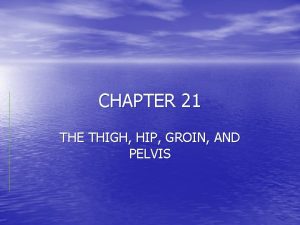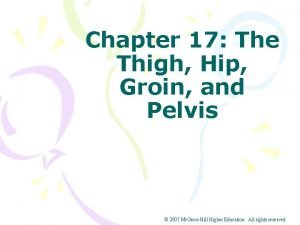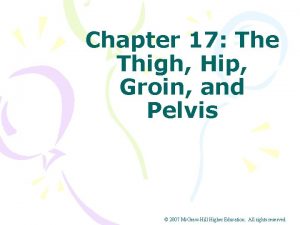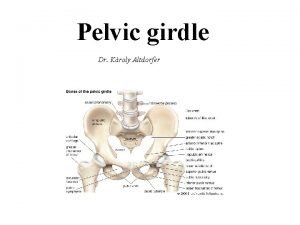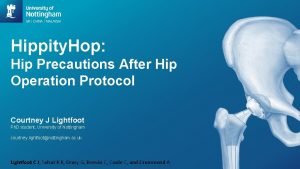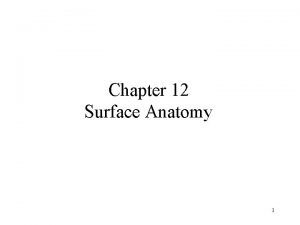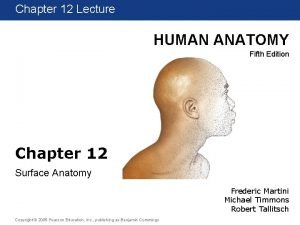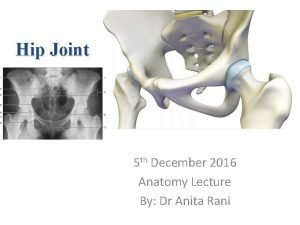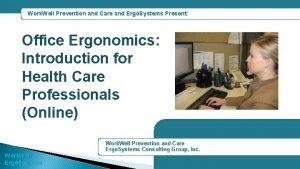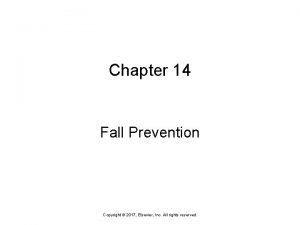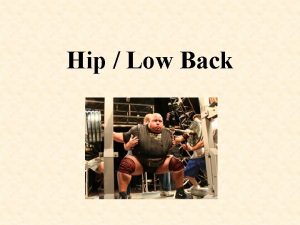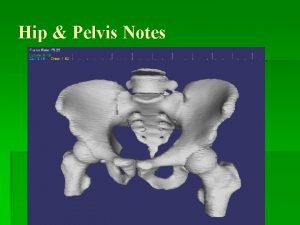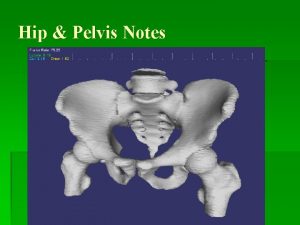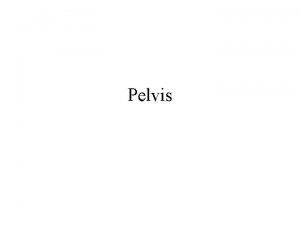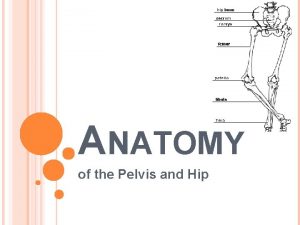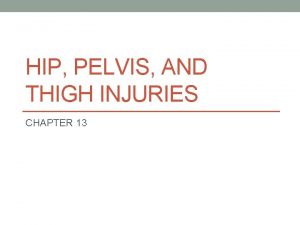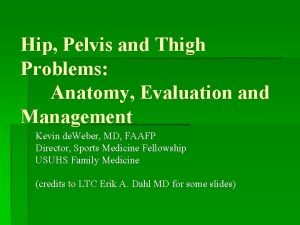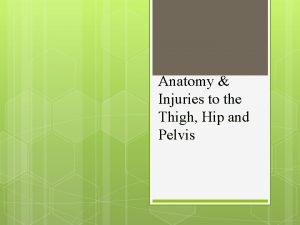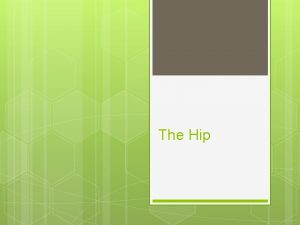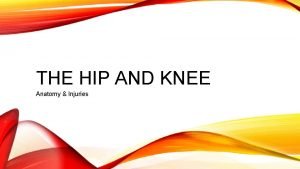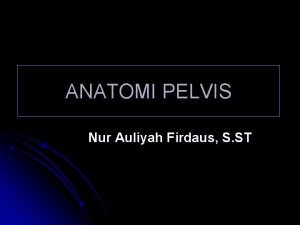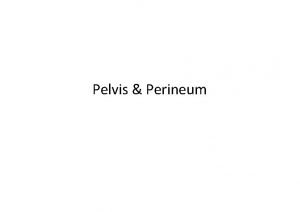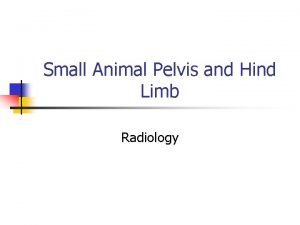Care Prevention Chapter Hip Pelvis Anatomy The arrangement































- Slides: 31

Care & Prevention Chapter Hip & Pelvis

Anatomy The arrangement of bones, ligaments, muscles, and tendons make the hip the strongest joint in the body.

Anatomy The hip joint is a ball and socket joint. • Note the femoral head of the femur sits in the socket of the hip.

Anatomy There two fused vertebrae known as the: • Sacrum • coccyx

Anatomy Groin & torso muscles are involved in supporting and moving the trunk, upper, and lower extremities.

Anatomy The hip and pelvis are supported by the following ligaments: • Ligamentum teres • Transverse acetabular • Iliofemoral • Pubofemoral • Inguinal

Anatomy The bones of the hip and pelvic region provide the structure to transfer weight between the torso and the lower extremities.

Important Muscle groups: • Gluteal Muscles (Largest) – Gluteus Medius – Gluteus Minimus – Gluteus Maximus Assist in hip extension, internal rotation, external rotation abduction

• Hip Flexors: – – Iliopsoas Sartorius Pectineus Rectus Femoris • Hip Adductors: – – Adductor Longus Adductor Brevis Adductor Magnus Gracilis

Anatomy Quadriceps Hip Flexion Hamstrings Hip Extension

Dermatome: the sensory distribution of a nerve root, which produces feeling in a certain area. Myotome: A single nerve root that produces movement in an area.

Anatomy Other Structures: • Fat Pads – Specialized soft tissue for weight bearing and absorbing impact. • Bursa – Synovial sacs generally located over bony prominences through the body.

Bones • Femur • Pelvis (Illium, Ischium, Pubis) • Sacrum • Coccyx Pelvic Girdle – the bony ring of the 2 innominate bones, the sacrum and the coccyx

Muscles Although all important a few stand out: • Gluteus Maximus – extension & adduction of hip • Gluteus Medius – abduction & external rotation of hip • Gluteus Minimus – abduction & internal rotation of hip • Tensor Fascia Latae: flexion & internal rotation of hip • Adductor (Longus/Brevis/Magnus) - adduction & flexion of the knee

Muscles cont. Hamstrings: Biceps Femoris – Flexion of knee / external rotation of leg Semimembranosus – Flexion of knee/internal rotation of leg Semitendinosus – Flexion of knee/internal rotation of leg Quadriceps: Rectus Femoris – Extension of knee / flexion of hip Vastus Medialis / Vastus Lateralis / Vastus Intermedius Extension of knee

Anatomical Planes Sagittal Plane – bisecting body into right and left halves Frontal Planes - bisecting body into front & back halves Transverse Planes - bisecting body into upper & lower halves

Range of Motion - Hip Adduction – moving leg toward the midline in the frontal plane Abduction – moving leg away from the midline of body in frontal plane Flexion – decreasing angle between anterior thigh & abdomen through the sagittal plane Extension – increasing the angle between anterior thigh and abdomen through the sagittal plane Internal Rotation – rotation of femur toward the midline External Rotation – rotation of femur away the midline

Range of Motion - TORSO Flexion – moving the torso forward through the sagittal plane Extension – moving the torso backward through the sagittal plane Lateral Flexion – moving the torso laterally (side to side) in the frontal plane Rotation – rotating the torso in the transverse plane

Vocabulary Dermatome: a segment of the skin that is innervated by a spinal nerve Innervated: nerve stimulation (usually of a muscle Both terms are used when inferring about the nerve innervations of the body

Common Injuries to the coccyx: Coccyx – A 4 fused vertebrae on the lower end of the spine. • AKA – Tail Bone Area can be bruised by falling or struck by a hard surface • Severe trauma can cause fracture of dislocation Treatment – Protection, rest, ice

Common Injuries Hip Strains • Commonly occur when the joint received violent twisting motion of the torso accompanied by stationary/fixed feet Evaluating – have athletes perform various ROM (flexion, extension, adductions, abduction, circumduction)

Hip Pointer • Some muscles that control trunk movement attach to the iliac crest. • Due to limited natural protection, injuries to the iliac crest result from direct blow, (contusion) and can disable an athlete. – Immediate pain & swelling may of may not be present initially.

Trauma to the genitalia • Result from direct blow or testicular torsion – Causes excruciating pain and temporary disability • Same physiological tissue reaction as contusions to other body parts – Hemorrhaging, fluid effusion, and muscle spasm • 1 method to relieve this spasm is to have the athlete lie on the ground and flex thighs to chest. Loosen clothing, Ice, & see physician. • Can occur to a female as well

Trochanteric Bursitis • Occurs at the bursa at the gluteus medius/iliotibial band insertion at greater trochanter. • Running technique should be examined • Common in dance

Hip Dislocation • Should be handled by emergency personnel • In most cases the athlete will be lying on their backs with the injured extremity flexed and externally rotated. • Injury caused by abnormal stress to the joint. – Can dislocate either anteriorly or posteriorly

Hip Dislocation cont. • The head of the femur could permanently damage nerves and blood supply *These athletes need to be transported.

Science Word Map • • Athlete Publgia Iliotibial Bans Syndrome Osteitis Pubis Piriformis Sysndrome

Rehabilitation Sending an athlete back to competition before healing is complete leaves the player susceptible to further injury. The best way to determine when healing is complete is by the absence of pain during stressful activity. Followed by Full pain free ROM

Rehabilitation Before the return to competition the following guidelines must be met: • Full Range of Motion • Strength, Power, and endurance are proportional to the athlete’s size, and sport • No pain during running, jumping, or cutting

Rehabilitation Before the beginning of any rehabilitation exercise program, the athletic trainer should consult with all members of the sports medicine team. Establish an individual program tailored for each athlete and their injury.

Rehabilitation Include in any Rehabilitation Protocol are the following: Range of Motion Exercise Resistance Exercise Cardiovascular/Fitness Activities (Walking, stairs, climbing, running, swimming, cycling) Sport Specific Activities (jumping, figure eights, Swimming, Jumping Rope)
 Retroversion vs anteversion
Retroversion vs anteversion Primary prevention secondary prevention tertiary prevention
Primary prevention secondary prevention tertiary prevention Chapter 17 the thigh hip groin and pelvis
Chapter 17 the thigh hip groin and pelvis Chapter 17 the thigh hip groin and pelvis
Chapter 17 the thigh hip groin and pelvis Hip fracture clinical care standard
Hip fracture clinical care standard Pelvis minor and major
Pelvis minor and major Hip hop hip to the hippity
Hip hop hip to the hippity Hip to the hippity hop
Hip to the hippity hop Nelaton's line
Nelaton's line Pelvis surface anatomy
Pelvis surface anatomy Anatomy region
Anatomy region Nelaton's line test
Nelaton's line test Primary secondary and tertiary care
Primary secondary and tertiary care Workwell prevention & care
Workwell prevention & care Cmmi oncology care model
Cmmi oncology care model Chapter 5 lesson 3 health
Chapter 5 lesson 3 health Chapter 19 disease transmission and infection prevention
Chapter 19 disease transmission and infection prevention Chapter 26 infectious disease prevention and control
Chapter 26 infectious disease prevention and control Chapter 19 disease transmission and infection prevention
Chapter 19 disease transmission and infection prevention Chapter 19 disease transmission and infection prevention
Chapter 19 disease transmission and infection prevention Chapter 14 fall prevention
Chapter 14 fall prevention Chapter 16 infection control and standard precautions
Chapter 16 infection control and standard precautions Define infection prevention chapter 5
Define infection prevention chapter 5 Hình ảnh bộ gõ cơ thể búng tay
Hình ảnh bộ gõ cơ thể búng tay Ng-html
Ng-html Bổ thể
Bổ thể Tỉ lệ cơ thể trẻ em
Tỉ lệ cơ thể trẻ em Voi kéo gỗ như thế nào
Voi kéo gỗ như thế nào Chụp tư thế worms-breton
Chụp tư thế worms-breton Bài hát chúa yêu trần thế alleluia
Bài hát chúa yêu trần thế alleluia Môn thể thao bắt đầu bằng chữ f
Môn thể thao bắt đầu bằng chữ f Thế nào là hệ số cao nhất
Thế nào là hệ số cao nhất
